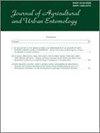苗圃花卉种类、来源和颜色对访粉昆虫数量和组成的影响
Q2 Agricultural and Biological Sciences
引用次数: 1
摘要
摘要近年来,随着传粉昆虫数量的减少,市民们开始积极设计支持传粉昆虫的花园。因此,花园中心已成为促进传粉昆虫保护的场所,尤其是在城市化地区。然而,关于哪些植物物种或植物特征吸引传粉昆虫,尤其是本地蜜蜂,缺乏循证指南。在位于西澳大利亚的一个花园苗圃(Zanthorea苗圃)进行了系统调查,以确定哪些植物对传粉昆虫最具吸引力。在2020/2021年的南方春季和夏季,观察了每种待售的开花植物,并在200秒的观察期内记录了所有昆虫访客。记录了本地蜜蜂的多样性,然而,引入的Apis mellifera L.占主导地位。在181种植物中,只有不到一半的物种接待了游客,植物物种对不同昆虫类群的吸引力差异很大。更丰富的植物物种对访问有积极影响。本地蜜蜂喜欢本地植物群,而蜜蜂喜欢本地和园艺品种。确定了所有昆虫造访次数最多的十种植物;其中三种(蓝白千层、蓝白波罗层和黄八灵虫)也是本地蜜蜂造访最多的物种。二分植物授粉网络揭示了昆虫类群和月份之间资源重叠和竞争潜力的差异。这项研究表明,在苗圃提供的花园植物物种中,昆虫有明显的偏好,应该推广参观过的植物,尤其是本地蜜蜂的植物,并大量种植。类似的调查可以用于为公众确定“对传粉昆虫友好”的植物群。本文章由计算机程序翻译,如有差异,请以英文原文为准。
The Influence of Plant Species, Origin and Color of Garden Nursery Flowers on the Number and Composition of Pollinating Insect Visitors
ABSTRACT With recent publicized pollinator declines, citizens are becoming motivated to design gardens that support pollinators. As a result, garden centers have become a venue for advancing pollinator conservation, especially in urbanised areas. However, there is a paucity of evidence-based guidelines on what plant species or plant characteristics attract pollinators, especially native bees. Systematic surveys were conducted to identify what plants are most attractive to pollinating insects at a garden nursery (Zanthorrea Nursery) located in Western Australia. In the austral spring and summer of 2020/2021, each blooming plant species for sale was observed and all insect visitors were recorded over a 200-sec observation period. A diversity of native bees was recorded, however, the introduced Apis mellifera L. dominated. Of the 181 plant species present, less than half received visitors, and plant species varied greatly in their attractiveness to different insect taxa. Greater abundance of a plant species positively influenced visitation. Native bees preferred native flora, whereas honeybees preferred both native and horticultural varieties. The ten most visited plants by all insects were identified; three of these (Melaleuca lanceolata, Boronia crenulata, and Babingtonia virgata) were also most visited by native bees. Bipartite plant-pollinator networks revealed that resource overlapped and potential for competition varied among insect taxa and months. This study indicated clear preferences by insects among garden plant species offered at nurseries, and visited plants, especially those by native bees, should be promoted, and planted in larger abundances. Similar surveys can be used to identify “pollinator friendly” flora for the public.
求助全文
通过发布文献求助,成功后即可免费获取论文全文。
去求助
来源期刊

The Journal of Agricultural and Urban Entomology
Agricultural and Biological Sciences-Insect Science
CiteScore
1.40
自引率
0.00%
发文量
2
期刊介绍:
The Journal of Agricultural and Urban Entomology (JAUE) (Journal of Agricultural Entomology, Jan 1984 - Oct 1998 volumes 1-15) is published under the auspices of the South Carolina Entomological Society (SCES). The Journal publishes contributions of original research concerning insects and other arthropods of agricultural and urban importance to include those affecting humans, livestock, poultry, and wildlife. JAUE is particularly dedicated to the publication of articles and notes pertaining to applied entomology, although it will accept suitable contributions of a fundamental nature related to agricultural and urban entomology.
 求助内容:
求助内容: 应助结果提醒方式:
应助结果提醒方式:


